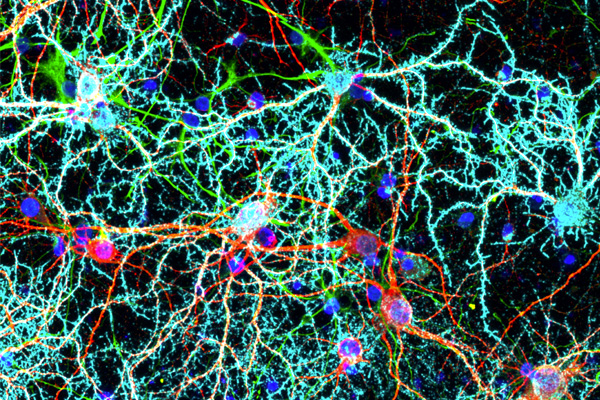Demystifying nano-neuro interactions
Srikanth Singamaneni and Barani Raman explore how nanoparticles bind to neurons with potential applications in treating brain, nerve disorders

Nanomaterials already play a vital role in enhancing the performance of everyday products from electronics to cosmetics to food packaging. But, beyond their usefulness in making images sharper and products more stable, researchers in the McKelvey School of Engineering at Washington University in St. Louis have shown nanoparticles may also be an essential tool in advancing our understanding of the brain and opening new avenues for treating neurological disorders such as Parkinson's disease and epilepsy.
Srikanth Singamaneni, the Lilyan & E. Lisle Hughes Professor in the Department of Mechanical Engineering & Materials Science, and Barani Raman, professor of biomedical engineering, received a three-year, $570,746 grant from the National Science Foundation to support their work to understand the fundamental mechanisms that underpin interactions between nerve cells, or neurons, and nanoparticles, which can be used to both sense and stimulate neurons.
“There’s a lot of excitement about harnessing the functional properties of nanomaterials – whether that’s magnetic nanoparticles or particles that can absorb light and turn it into heat or many other functions,” Singamaneni said. “Functional nanomaterials could be used for nongenetic modulation of neural activity and for solving some of the biggest challenges associated with diagnosing and treating neurodegenerative diseases.
“Nanoparticles can serve as a valuable toolkit,” he added. “But for that to happen, the fundamental roadblock is we still don’t know how nanoparticles interact with neurons, the fundamental building blocks that form the brain and neural circuits.”
Singamaneni and Raman, in collaboration with researchers in McKelvey Engineering and WashU’s School of Medicine, have already shown that nanoparticles can be used to boost locusts’ sense of smell by amplifying neuron signals in an insect’s brain to achieve better chemical sensing performance. With this new study, they aim to provide the physical underpinnings, or basic ground rules, for nano-neuro interactions using 2D neural cultures as a model system.
“Once we have the ground rules and understand how neurons and nanoparticles bind, then there are lots of applications,” Raman said. “For example, we could use nanoparticles for targeting select types of neurons, such as the dopaminergic neurons that are progressively lost during Parkinson’s disease. Nanoparticles can be potentially used to stimulate or control affected types of sub-neurons in the brain with fine temporal precision, then they can be safely flushed out.”
To achieve this level of fine control, Singamaneni and Raman will develop a detailed understanding of how nanoparticles mechanically bind to neurons, which they already know depends on the maturity of the neurons from their previous work. They also will explore the effects of nanoparticle binding on the electrical properties and activity of neurons, including how they process information. Both will be critical considerations to design nanomaterials to support neuroscientific discovery and minimally invasive technologies to treat neuronal disorders.





